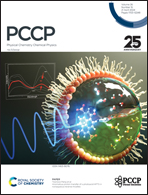Observation of spin-splitting energies on sp–d exchange interactions tailored in colloidal CdSe/CdMnS core/shell nanoplatelets: an atomistic tight-binding model
Abstract
Using the atomistic tight-binding model plus sp–d exchange term, the embedding of magnetic ions into CdSe/CdMnS core/shell nanoplatelets (NPLs) at different effective temperatures resulted in sp–d exchange interactions, which in turn cause modifications in electronic and magnetic characteristics. The influence of CdMnS monolayers on single-particle spectra, optical band gaps, wave function overlaps and exciton binding energies is more pronounced than that of the effective temperature. Due to the electron, hole and Zeeman splitting energies, with the growth of CdMnS shell monolayers, electron g-factor values are unchanged, but hole and exciton g-factor values are enhanced. Additionally, all g values decrease with increasing temperature, thus representing decreased magnetization of the paramagnetic system. By changing nanoplatelet architectures and temperatures, manipulation of s–d and p–d exchange interactions is accomplished. Overall, studied materials combine the merits of NPLs and magnetic ions, hence leading to alternate possibilities for active applications in spin-based devices.



 Please wait while we load your content...
Please wait while we load your content...